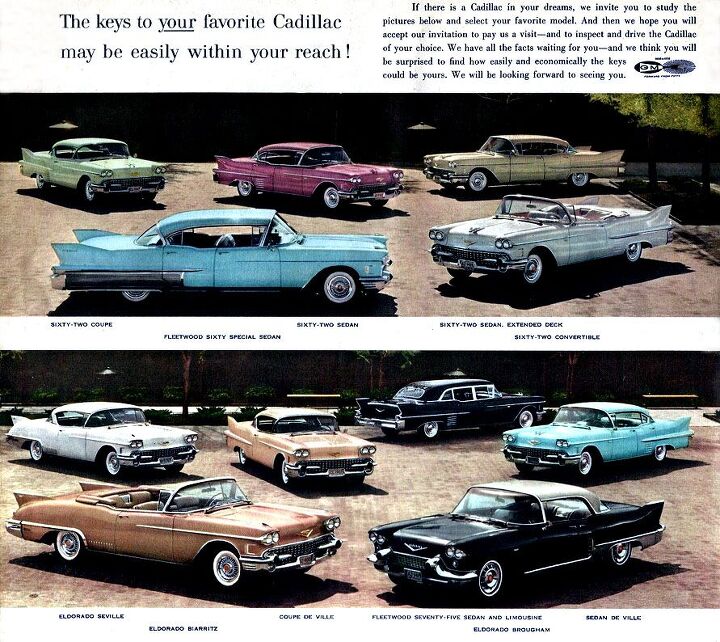#Ttac
Rare Rides Icons: The Cadillac Eldorado, Distinctly Luxurious (Part XXIII)
Last week we reviewed the dramatic and super finned exterior design of the 1959 Eldorado, in its two-door Seville hardtop coupe format. While its less popular convertible sibling Biarritz received matching styling in all ways except its roof, there was exclusive and different styling reserved for the third type of Eldorado: the four-door Brougham. Assembled by hand in Italy at Pininfarina, the large sedan was very rare, a last-of-type, and was a sneak peek of future Cadillacs.
Rare Rides Icons: The Cadillac Eldorado, Distinctly Luxurious (Part XXII)
Rare Rides Icons: The Cadillac Eldorado, Distinctly Luxurious (Part XXI)
It was time for a new styling theme at Cadillac in 1959, when lead designer Harley Earl reached mandatory retirement age. Bill Mitchell, longtime right hand man and team succeeded Earl and implemented immediate styling changes. Some of those - like huge fins - were to compete with Chrysler and Imperial designs, but others were an effort at streamlining and modernization; moving away from post-War looks. Today we’ll take a look at the changes underneath these grandiose and (often) pink metallic bodies.
Rare Rides Icons: The Cadillac Eldorado, Distinctly Luxurious (Part XX)
Rare Rides Icons: The Cadillac Eldorado, Distinctly Luxurious (Part XIX)
We’re back with more Cadillac Eldorado today, in our final entry on the third generation models. We spent our last installment reviewing the special and sometimes troublesome engineering that was standard on the Brougham. Since then, I discovered this April 1957 edition of The Cadillac Serviceman, GM’s in-house magazine publication for its dealer service centers. Twelve clearly scanned pages of technical and service detail await you! After reading, return here and learn about the changes made to the Eldorado line in 1958.
Rare Rides Icons: The Cadillac Eldorado, Distinctly Luxurious (Part XVIII)
We’re back with more Cadillac Eldorado coverage this week. In our last installment (over a month ago) we reviewed the interior accouterments of the Eldorado Brougham that were far beyond the standard Eldorado. Aside from its coach door hardtop body style, the other area where the Brougham went its own way was in engineering. And some of that engineering was of the experimental variety. What could go wrong?
In Memoriam: Marcello Gandini, an Automotive Design Master
The world lost one of its preeminent car designers today, as Marcello Gandini has passed away at the age of 85. Though perhaps best known for the flashy and outrageous Lamborghini Countach, Gandini’s pen was applied to many other Italian, German, French, British, Japanese, and Swedish concepts and production designs. Gandini’s prolific portfolio of work made a permanent mark on automotive design.
The Grand Tour's "Sand Job," Nothing to See Here, I'm Afraid
Just short of the eight-month mark, Amazon’s expensive The Grand Tour is back for its penultimate episode. Following last summer’s “ Eurocrash,” the maturely titled “Sand Job” sends the trio of presenters to an all-new location to tread upon content ground they’ve crossed many times previously. And though the special is sparse on content, it’s certainly coming with length.
Rare Rides Icons: The Cadillac Eldorado, Distinctly Luxurious (Part XVII)
In our last installment of Rare Rides, we checked out the interior changes Cadillac’s engineers and designers made for the new and improved third generation Eldorado in 1957. And while the interior of the standard Eldorados that year was largely shared with the rest of the Cadillac lineup, there was an exception: Eldorado Brougham. Like we saw previously with the Brougham’s mix-and-match approach in use of old and new exterior styling cues, the interior went its own direction as well.
Rare Rides Icons: The Cadillac Eldorado, Distinctly Luxurious (Part XVI)
We spent our last installment reviewing the more modern exterior styling of the 1957 Eldorado Seville, and new-yet-dated looking Eldorado Brougham. Those two followed our coverage of the Eldorado Biarritz, which was unable to adopt Cadilac’s 1957 roof and pillars design because of its canvas roof. This week we step inside the Eldorado, and see how removed it was from the 1956 models.
Rare Rides Icons: The Cadillac Eldorado, Distinctly Luxurious (Part XV)
Last week in our Cadillac Eldorado saga, we covered the visual updates in the new-for-’57 Eldorado Biarritz. Part of a styling revision across the line at Cadillac that year, the Eldorado in particular drifted away from the bulbous fenders and tall hood shapes that were a hallmark of post-WWII American car design. But there were two more Eldorados in 1957! One of them looked more daring than the Biarritz, and the other looked almost like it was from the past.
Rare Rides Icons: The Cadillac Eldorado, Distinctly Luxurious (Part XIV)
As we learned in our previous installment, the third generation Eldorado debuted in 1957 with a daring new X-frame chassis design. Launched across the entire Cadillac lineup that year, the X-frame would become controversial in short order due to safety concerns in side-impact crashes. Up top, Cadillac decided to make less controversial styling changes on the 1957 Eldorados. Designers advanced a styling theme that would reach its fin-happy and chrome bedazzled crescendo a couple of years later.
Rare Rides Icons: The Cadillac Eldorado, Distinctly Luxurious (Part XIII)
As we learned in our last installment, the Cadillac lineup was revised visually for 1957, and would be revised again in 1958 once quad headlamps became legal. Fins grew, hoods smoothed, roofs leaned backward, and there were more Eldorado variants than ever before. But styling and lineup changes weren’t the only new features in 1957: Cadillac was also eager to tout its Standard of the World engineering, safety, and engine advancements!
Rare Rides Icons: The Cadillac Eldorado, Distinctly Luxurious (Part XII)
The second generation Cadillac Eldorado was met with immediate sales success after its repositioning from a halo vehicle to a more affordable upmarket trim package in 1954. Expanding upon the success in its third and final model year, the second-gen Eldorado sprouted a new body style (a hardtop coupe) called Seville in addition to the mainstay convertible sibling christened Biarritz. In 1958 it was time for all-new Eldorado(s), in a moment that would see the nameplate expand into a small lineup in two very distinct price brackets. Time for model range detail!
Housekeeping: The TTAC Podcast Returns!
Hey there! Remember the podcast we did until early last year? It was put on hiatus for a variety of reasons we'll keep in house -- and now, it's back!






























Recent Comments